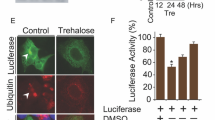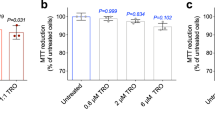Abstract
Accumulation of misfolded or aberrant proteins in neuronal cells is linked with neurodegeneration and other pathologies. Which molecular mechanisms fail and cause inappropriate folding of proteins and what is their relationship to cellular toxicity is not well known. How does it happen and what are the probable therapeutic or molecular approaches to counter them are also not clear. Here, we demonstrate that treatment of lanosterol diminishes aberrant proteotoxic aggregation and mitigates their cytotoxicity via induced expression of co-chaperone CHIP and elevated autophagy. The addition of lanosterol not only reduces aggregation of mutant bonafide misfolded proteins but also effectively prevents accumulation of various mutant disease-prone proteotoxic proteins. Finally, we observed that lanosterol mitigates cytotoxicity in cells, mediated by different stress-inducing agents. Taken together, our present results suggest that upregulation of cellular molecular chaperones, primarily using small molecules, can probably offer an efficient therapeutic approach in the future against misfolding of different disease-causing proteins and neurodegenerative disorders.

ᅟ









Similar content being viewed by others
References
Woerner AC, Frottin F, Hornburg D, Feng LR, Meissner F, Patra M, Tatzelt J, Mann M et al (2016) Cytoplasmic protein aggregates interfere with nucleocytoplasmic transport of protein and RNA. Science 351(6269):173–176. doi:10.1126/science.aad2033
Chhangani D, Mishra A (2013) Protein quality control system in neurodegeneration: a healing company hard to beat but failure is fatal. Mol Neurobiol 48(1):141–156. doi:10.1007/s12035-013-8411-0
Chhangani D, Mishra A (2013) Mahogunin ring finger-1 (MGRN1) suppresses chaperone-associated misfolded protein aggregation and toxicity. Sci Rep 3:1972. doi:10.1038/srep01972
Kaganovich D, Kopito R, Frydman J (2008) Misfolded proteins partition between two distinct quality control compartments. Nature 454(7208):1088–1095. doi:10.1038/nature07195
Olzscha H, Schermann SM, Woerner AC, Pinkert S, Hecht MH, Tartaglia GG, Vendruscolo M, Hayer-Hartl M et al (2011) Amyloid-like aggregates sequester numerous metastable proteins with essential cellular functions. Cell 144(1):67–78. doi:10.1016/j.cell.2010.11.050
Ciechanover A, Kwon YT (2015) Degradation of misfolded proteins in neurodegenerative diseases: therapeutic targets and strategies. Exp Mol Med 47:e147. doi:10.1038/emm.2014.117
Bennett EJ, Bence NF, Jayakumar R, Kopito RR (2005) Global impairment of the ubiquitin-proteasome system by nuclear or cytoplasmic protein aggregates precedes inclusion body formation. Mol Cell 17(3):351–365. doi:10.1016/j.molcel.2004.12.021
Cohen FE, Kelly JW (2003) Therapeutic approaches to protein-misfolding diseases. Nature 426(6968):905–909. doi:10.1038/nature02265
Chaudhuri TK, Paul S (2006) Protein-misfolding diseases and chaperone-based therapeutic approaches. FEBS J 273(7):1331–1349. doi:10.1111/j.1742-4658.2006.05181.x
Yang YP, Hu LF, Zheng HF, Mao CJ, Hu WD, Xiong KP, Wang F, Liu CF (2013) Application and interpretation of current autophagy inhibitors and activators. Acta Pharmacol Sin 34(5):625–635. doi:10.1038/aps.2013.5
Sarkar N, Kumar M, Dubey VK (2011) Exploring possibility of promiscuity of amyloid inhibitor: studies on effect of selected compounds on folding and amyloid formation of proteins. Process Biochem 46(5):1179–1185. doi:10.1016/j.procbio.2011.02.010
Parenti G (2009) Treating lysosomal storage diseases with pharmacological chaperones: from concept to clinics. EMBO Mol Med 1(5):268–279. doi:10.1002/emmm.200900036
Haynes CM, Titus EA, Cooper AA (2004) Degradation of misfolded proteins prevents ER-derived oxidative stress and cell death. Mol Cell 15(5):767–776. doi:10.1016/j.molcel.2004.08.025
Pan JA, Ullman E, Dou Z, Zong WX (2011) Inhibition of protein degradation induces apoptosis through a microtubule-associated protein 1 light chain 3-mediated activation of caspase-8 at intracellular membranes. Mol Cell Biol 31(15):3158–3170. doi:10.1128/MCB.05460-11
Upadhyay A, Amanullah A, Chhangani D, Joshi V, Mishra R, Mishra A (2015) Ibuprofen induces mitochondrial-mediated apoptosis through proteasomal dysfunction. Mol Neurobiol. doi:10.1007/s12035-015-9603-6
Hartl FU, Bracher A, Hayer-Hartl M (2011) Molecular chaperones in protein folding and proteostasis. Nature 475(7356):324–332. doi:10.1038/nature10317
Zhang Y, Ahn YH, Benjamin IJ, Honda T, Hicks RJ, Calabrese V, Cole PA, Dinkova-Kostova AT (2011) HSF1-dependent upregulation of Hsp70 by sulfhydryl-reactive inducers of the KEAP1/NRF2/ARE pathway. Chem Biol 18(11):1355–1361. doi:10.1016/j.chembiol.2011.09.008
Wright JM, Zeitlin PL, Cebotaru L, Guggino SE, Guggino WB (2004) Gene expression profile analysis of 4-phenylbutyrate treatment of IB3-1 bronchial epithelial cell line demonstrates a major influence on heat-shock proteins. Physiol Genomics 16(2):204–211. doi:10.1152/physiolgenomics.00160.2003
Jurivich DA, Sistonen L, Sarge KD, Morimoto RI (1994) Arachidonate is a potent modulator of human heat shock gene transcription. Proc Natl Acad Sci U S A 91(6):2280–2284
Teiten MH, Reuter S, Schmucker S, Dicato M, Diederich M (2009) Induction of heat shock response by curcumin in human leukemia cells. Cancer Lett 279(2):145–154. doi:10.1016/j.canlet.2009.01.031
Mori M, Li G, Abe I, Nakayama J, Guo Z, Sawashita J, Ugawa T, Nishizono S et al (2006) Lanosterol synthase mutations cause cholesterol deficiency-associated cataracts in the Shumiya cataract rat. J Clin Invest 116(2):395–404. doi:10.1172/JCI20797
Song BL, Javitt NB, DeBose-Boyd RA (2005) Insig-mediated degradation of HMG CoA reductase stimulated by lanosterol, an intermediate in the synthesis of cholesterol. Cell Metab 1(3):179–189. doi:10.1016/j.cmet.2005.01.001
Huff MW, Telford DE (2005) Lord of the rings—the mechanism for oxidosqualene:lanosterol cyclase becomes crystal clear. Trends Pharmacol Sci 26(7):335–340. doi:10.1016/j.tips.2005.05.004
Lim L, Jackson-Lewis V, Wong LC, Shui GH, Goh AX, Kesavapany S, Jenner AM, Fivaz M et al (2012) Lanosterol induces mitochondrial uncoupling and protects dopaminergic neurons from cell death in a model for Parkinson’s disease. Cell Death Differ 19(3):416–427. doi:10.1038/cdd.2011.105
Zhao L, Chen XJ, Zhu J, Xi YB, Yang X, Hu LD, Ouyang H, Patel SH et al (2015) Lanosterol reverses protein aggregation in cataracts. Nature 523(7562):607–611. doi:10.1038/nature14650
Chhangani D, Upadhyay A, Amanullah A, Joshi V, Mishra A (2014) Ubiquitin ligase ITCH recruitment suppresses the aggregation and cellular toxicity of cytoplasmic misfolded proteins. Sci Rep 4:5077. doi:10.1038/srep05077
Chhangani D, Endo F, Amanullah A, Upadhyay A, Watanabe S, Mishra R, Yamanaka K, Mishra A (2015) Mahogunin ring finger 1 confers cytoprotection against mutant SOD1 aggresomes and is defective in an ALS mouse model. Neurobiol Dis 86:16–28. doi:10.1016/j.nbd.2015.11.017
Trott O, Olson AJ (2010) AutoDock Vina: improving the speed and accuracy of docking with a new scoring function, efficient optimization, and multithreading. J Comput Chem 31(2):455–461. doi:10.1002/jcc.21334
Pettersen EF, Goddard TD, Huang CC, Couch GS, Greenblatt DM, Meng EC, Ferrin TE (2004) UCSF chimera—a visualization system for exploratory research and analysis. J Comput Chem 25(13):1605–1612. doi:10.1002/jcc.20084
Stierand K, Maass PC, Rarey M (2006) Molecular complexes at a glance: automated generation of two-dimensional complex diagrams. Bioinformatics 22(14):1710–1716. doi:10.1093/bioinformatics/btl150
Bjørkøy G, Lamark T, Pankiv S, Øvervatn A, Brech A, Johansen T (2009) Chapter 12 Monitoring autophagic degradation of p62/SQSTM1. In: Methods in Enzymology, vol 452. Academic Press, New York, p 181–197. doi:10.1016/S0076-6879(08)03612-4
Komatsu M, Ichimura Y (2010) Physiological significance of selective degradation of p62 by autophagy. FEBS Lett 584(7):1374–1378. doi:10.1016/j.febslet.2010.02.017
Arslan MA, Chikina M, Csermely P, Soti C (2012) Misfolded proteins inhibit proliferation and promote stress-induced death in SV40-transformed mammalian cells. FASEB journal: official publication of the Federation of American Societies for Experimental Biology 26(2):766–777. doi:10.1096/fj.11-186197
Sisodia SS (1998) Nuclear inclusions in glutamine repeat disorders: are they pernicious, coincidental, or beneficial? Cell 95(1):1–4
Suzuki Y (2014) Emerging novel concept of chaperone therapies for protein misfolding diseases. Proceedings of the Japan Academy Series B, Physical and biological sciences 90(5):145–162
Perlmutter DH (2002) Chemical chaperones: a pharmacological strategy for disorders of protein folding and trafficking. Pediatr Res 52(6):832–836. doi:10.1203/00006450-200212000-00004
Connell P, Ballinger CA, Jiang J, Wu Y, Thompson LJ, Hohfeld J, Patterson C (2001) The co-chaperone CHIP regulates protein triage decisions mediated by heat-shock proteins. Nat Cell Biol 3(1):93–96. doi:10.1038/35050618
Meacham GC, Patterson C, Zhang W, Younger JM, Cyr DM (2001) The Hsc70 co-chaperone CHIP targets immature CFTR for proteasomal degradation. Nat Cell Biol 3(1):100–105. doi:10.1038/35050509
Xu W, Marcu M, Yuan X, Mimnaugh E, Patterson C, Neckers L (2002) Chaperone-dependent E3 ubiquitin ligase CHIP mediates a degradative pathway for c-ErbB2/Neu. Proc Natl Acad Sci U S A 99(20):12847–12852. doi:10.1073/pnas.202365899
McDonough H, Patterson C (2003) CHIP: a link between the chaperone and proteasome systems. Cell Stress Chaperones 8(4):303–308
Kilpatrick K, Novoa JA, Hancock T, Guerriero CJ, Wipf P, Brodsky JL, Segatori L (2013) Chemical induction of Hsp70 reduces alpha-synuclein aggregation in neuroglioma cells. ACS Chem Biol 8(7):1460–1468. doi:10.1021/cb400017h
Wang AM, Miyata Y, Klinedinst S, Peng HM, Chua JP, Komiyama T, Li X, Morishima Y et al (2013) Activation of Hsp70 reduces neurotoxicity by promoting polyglutamine protein degradation. Nat Chem Biol 9(2):112–118. doi:10.1038/nchembio.1140
Makley LN, McMenimen KA, DeVree BT, Goldman JW, McGlasson BN, Rajagopal P, Dunyak BM, McQuade TJ et al (2015) Pharmacological chaperone for alpha-crystallin partially restores transparency in cataract models. Science 350(6261):674–677. doi:10.1126/science.aac9145
Urushitani M, Kurisu J, Tateno M, Hatakeyama S, Nakayama K, Kato S, Takahashi R (2004) CHIP promotes proteasomal degradation of familial ALS-linked mutant SOD1 by ubiquitinating Hsp/Hsc70. J Neurochem 90(1):231–244. doi:10.1111/j.1471-4159.2004.02486.x
Shin Y, Klucken J, Patterson C, Hyman BT, McLean PJ (2005) The co-chaperone carboxyl terminus of Hsp70-interacting protein (CHIP) mediates alpha-synuclein degradation decisions between proteasomal and lysosomal pathways. J Biol Chem 280(25):23727–23734. doi:10.1074/jbc.M503326200
Miller VM, Nelson RF, Gouvion CM, Williams A, Rodriguez-Lebron E, Harper SQ, Davidson BL, Rebagliati MR et al (2005) CHIP suppresses polyglutamine aggregation and toxicity in vitro and in vivo. J Neurosci 25(40):9152–9161. doi:10.1523/JNEUROSCI.3001-05.2005
Jana NR, Dikshit P, Goswami A, Kotliarova S, Murata S, Tanaka K, Nukina N (2005) Co-chaperone CHIP associates with expanded polyglutamine protein and promotes their degradation by proteasomes. J Biol Chem 280(12):11635–11640. doi:10.1074/jbc.M412042200
Arndt V, Dick N, Tawo R, Dreiseidler M, Wenzel D, Hesse M, Furst DO, Saftig P et al (2010) Chaperone-assisted selective autophagy is essential for muscle maintenance. Curr Biol 20(2):143–148. doi:10.1016/j.cub.2009.11.022
Tanaka M, Machida Y, Niu S, Ikeda T, Jana NR, Doi H, Kurosawa M, Nekooki M et al (2004) Trehalose alleviates polyglutamine-mediated pathology in a mouse model of Huntington disease. Nat Med 10(2):148–154. doi:10.1038/nm985
Acknowledgements
This work was supported by the Department of Biotechnology, Government of India. AM was supported by Ramalinganswami Fellowship (BT/RLF/Reentry/11/2010) and Extra Mural Research Funding (Individual Centric): Science and Engineering Research Board (SERB) EMR/2016/000716, Department of Science and Technology, Government of India. AU was supported by a research fellowship from University Grants Commission, Council of Scientific and Industrial Research, Government of India. The authors would like to thank Mr. Bharat Pareek for his technical assistance and entire lab management during the manuscript preparation. We also thank to all for gifted plasmids: Dr. Csaba soti (Department of Medical Chemistry, Semmelweis University, Budapest, Hungary) for GFP-wtCAT and GFP-Δ9CAT constructs, Dr. Hilal Lashuel (Laboratory of Molecular and Chemical Biology of Neurodegeneration, Brain Mind Institute, School of Life Sciences, for α-Synuclein and α-Synuclein-S87A plasmids, Ecole Polytechnique Fédérale de Lausanne, CH-1015 Lausanne, Switzerland), Dr. A Tunnacliffe (Department of Chemical Engineering and Biotechnology, University of Cambridge, Cambridge, UK) for EGFP-HDQ23 and EGFP-HDQ74 constructs, Dr. Elizabeth Fisher (UCL Institute of Neurology, Queen Square, London) for pF141 pAcGFP1 SOD1WT and pF148 pSOD1G37RAcGFP1 plasmids, Dr. Henry L. Paulson (The University of Michigan Health System, Department of Neurology, Ann Arbor, MI) for pEGFP-C1-Ataxin3Q28 and pEGFP-C1-Ataxin3Q84 constructs, and Dr. William Kaelin from Dana Farber Cancer Institute and the Howard Hughes Medical Institute for luciferase-pcDNA3 plasmid.
Author information
Authors and Affiliations
Corresponding author
Ethics declarations
Conflict of Interest
The authors declare that they have no conflict of interests.
Additional information
Arun Upadhyay and Ayeman Amanullah contributed equally to this work.
Rights and permissions
About this article
Cite this article
Upadhyay, A., Amanullah, A., Mishra, R. et al. Lanosterol Suppresses the Aggregation and Cytotoxicity of Misfolded Proteins Linked with Neurodegenerative Diseases. Mol Neurobiol 55, 1169–1182 (2018). https://doi.org/10.1007/s12035-016-0377-2
Received:
Accepted:
Published:
Issue Date:
DOI: https://doi.org/10.1007/s12035-016-0377-2




